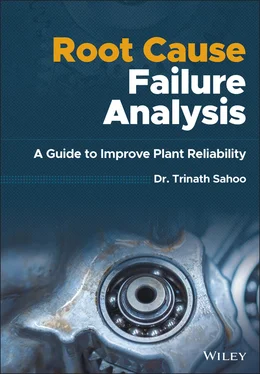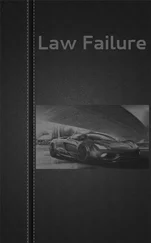Trinath Sahoo - Root Cause Failure Analysis
Здесь есть возможность читать онлайн «Trinath Sahoo - Root Cause Failure Analysis» — ознакомительный отрывок электронной книги совершенно бесплатно, а после прочтения отрывка купить полную версию. В некоторых случаях можно слушать аудио, скачать через торрент в формате fb2 и присутствует краткое содержание. Жанр: unrecognised, на английском языке. Описание произведения, (предисловие) а так же отзывы посетителей доступны на портале библиотеки ЛибКат.
- Название:Root Cause Failure Analysis
- Автор:
- Жанр:
- Год:неизвестен
- ISBN:нет данных
- Рейтинг книги:5 / 5. Голосов: 1
-
Избранное:Добавить в избранное
- Отзывы:
-
Ваша оценка:
- 100
- 1
- 2
- 3
- 4
- 5
Root Cause Failure Analysis: краткое содержание, описание и аннотация
Предлагаем к чтению аннотацию, описание, краткое содержание или предисловие (зависит от того, что написал сам автор книги «Root Cause Failure Analysis»). Если вы не нашли необходимую информацию о книге — напишите в комментариях, мы постараемся отыскать её.
Provides the knowledge and failure analysis skills necessary for preventing and investigating process equipment failures Root Cause Failure Analysis: A Guide to Improve Plant Reliability
Root Cause Failure Analysis: A Guide to Improve Plant Reliability
Root Cause Failure Analysis — читать онлайн ознакомительный отрывок
Ниже представлен текст книги, разбитый по страницам. Система сохранения места последней прочитанной страницы, позволяет с удобством читать онлайн бесплатно книгу «Root Cause Failure Analysis», без необходимости каждый раз заново искать на чём Вы остановились. Поставьте закладку, и сможете в любой момент перейти на страницу, на которой закончили чтение.
Интервал:
Закладка:
How to Control Corrosion
There are many ways to organize and operate successful corrosion management systems, each of which is asset specific depending on factors such as Design, Stage in life cycle, Process conditions, and Operational history. The corrosion policy provides a structured framework for identification of risks associated with corrosion, and the development and operation of suitable risk control measures.
Corrosion is caused by a chemical reaction between the metal and gases in the surrounding environment. By taking measures to control the environment, these unwanted reactions can be minimized. Sacrificial coating involves coating the metal with an additional metal type that is more likely to oxidize, hence the term “sacrificial coating.” There are two main techniques for achieving sacrificial coating: cathodic protection and anodic protection. The most common example of cathodic protection is the coating of iron alloy steel with zinc, a process known as galvanizing. Anodic protection involves coating the iron alloy steel with a less active metal, such as tin. Tin will not corrode, so the steel will be protected as long as the tin coating is in place.
Another simple way to prevent corrosion is to use a corrosion‐resistant metal such as aluminum or stainless steel. Depending on the application, these metals can be used to reduce the need for additional corrosion protection. Though the application of a paint coating is a cost‐effective way of preventing corrosion. Paint coatings act as a barrier to prevent the transfer of electrochemical charge from the corrosive solution to the metal underneath. Corrosion inhibitors can be applied as a solution or as a protective coating using dispersion techniques. Corrosion inhibitors are commonly applied via a process known as passivation. Corrosion inhibitors are chemicals that react with the surface of the metal or the surrounding gases to suppress the electrochemical reactions leading to corrosion. They work by being applied to the surface of a metal where they form a protective film. Cathodic protection (CP) is by far the best way to stop corrosion on pipelines. It uses impressed currents from a fixed anode to interfere with the electrical circuit in the corrosion cell. It is 100% effective against most forms of external pipe corrosion.
Wear and Erosion Damage
Wear and erosion involve loss of material. This may be, for example, because of the absence of adequate lubrication, the rubbing together of components that are supposed to have clearance between them, or from the handling of abrasive materials that impinge on the component that continually removes surface material. In many cases, the presence of debris buildup may provide critical understanding of the specific wear/erosion mechanism involved in the failure. A common wear problem that is encountered relates to bearings, either roller‐element bearings or plain bearings. Features to be looked for include the nature of the damage, for example, overall wear or scores in the bearing surfaces. In the latter case, it is particularly important to identify any hard particles that may be embedded and trapped at the ends of the score marks. Where unexpected wear between components in relative motion is encountered, and lubrication is observed to have been adequate, it is important to look for possible contaminants. These may arise from some other component in the system (for example, through the loss of hard chromium plating particles or through the development of corrosion products that are then transmitted through the system in circulating lubricant).
Failure Investigation
Two of the critical goals in a failure investigation are to identify both the failure mechanism(s) and failure mode(s) that are present. Failure mechanisms are a key component in categorizing damage and failures.
Stages of a Failure Analysis
Depending on the nature of the failure and the availability of physical evidence or background information, there are stages that are common to all successful failure analysis. Steps may be followed by assessment of the damage and conditions leading to failure. These stages may differ depending on whether fracture, corrosion, and/or wear conditions are being investigated.
Generally, a failure analyst will start with a broad range of possible explanations but over time will narrow and refine the existing possibilities. Often, a likely theory develops during the course of the investigation. This can be helpful, but only if the investigator does not let the theory influence his or her objectivity.
The Principal Task of a failure analyst during a physical cause investigation is to identify the sequence of events involved in the failure. Technical skills and tools are required for such identification, but the analyst also needs a mental organizational framework that helps evaluate the significance of observations.
The basic steps are:
1 Collect data
2 Identify damage modes present
3 Identify possible damage mechanisms
4 Test to identify actual mechanisms that occurred
5 Identify which mechanism is primary and which is/are secondary
6 Identify possible root causes
7 Test to determine actual root cause
8 Evaluate and implement corrective actions
Collection of Background Data and Samples
The first step in a failure investigation involves gathering background information. This includes material, manufacturing process, circumstances surrounding the failure, engineering drawings, associated specifications and other background data. In addition to the failed component, it is also helpful to have an intact, unused, “exemplar” for examination. An experienced failure analyst can assist in the discovery process to obtain relevant documentation
Information about the failure:
Date and time of failure, temperature, and environment
Extent of damage, sequence of failure, and injuries
Stage of operation when failure occurred
Blueprints, photographs, or sketches of the failure and adjacent areas
Any service deviations that might have contributed to the failure
Opinions of operating personnel regarding the failure
But for the analysis of some components, it may be impractical or impossible for the failure analyst to visit the failure site. Under these circumstances, data and samples may be collected at the site by field engineers or by other personnel under the direction of the failure analyst. A field failure report sheet or checklist can be used to ensure that all pertinent information regarding the failure is recorded.
Visual Examination
The failed part, including all its fragments, should be subjected to a thorough visual examination before any cleaning is undertaken. For example, traces of paint or corrosion found on a portion of a fracture surface may provide evidence that the crack was present in the surface for some time before complete fracture occurred. The preliminary examination should begin with unaided visual inspection. The unaided eye has exceptional depth of focus, the ability to examine large areas rapidly and to detect changes of color and texture. If required, macroscopic examination is performed to document the main features by using low‐power magnification. It is important at this stage to fully document the “as‐received” condition and photograph overall fracture and position. The temptation to put fracture surfaces back together should be avoided as it can damage fracture features. Because metallic parts are prone to oxidation, a reaction between the metal and the oxygen in the air, failed components should ideally be examined as soon as possible. Documentation of damage and cracking surrounding a fracture, including damage patterns and crack origins, scores, scuffing, dents, distortions, evidence of plastic deformation, and fractures is an important step in assessing relevance to final failure.
Читать дальшеИнтервал:
Закладка:
Похожие книги на «Root Cause Failure Analysis»
Представляем Вашему вниманию похожие книги на «Root Cause Failure Analysis» списком для выбора. Мы отобрали схожую по названию и смыслу литературу в надежде предоставить читателям больше вариантов отыскать новые, интересные, ещё непрочитанные произведения.
Обсуждение, отзывы о книге «Root Cause Failure Analysis» и просто собственные мнения читателей. Оставьте ваши комментарии, напишите, что Вы думаете о произведении, его смысле или главных героях. Укажите что конкретно понравилось, а что нет, и почему Вы так считаете.












